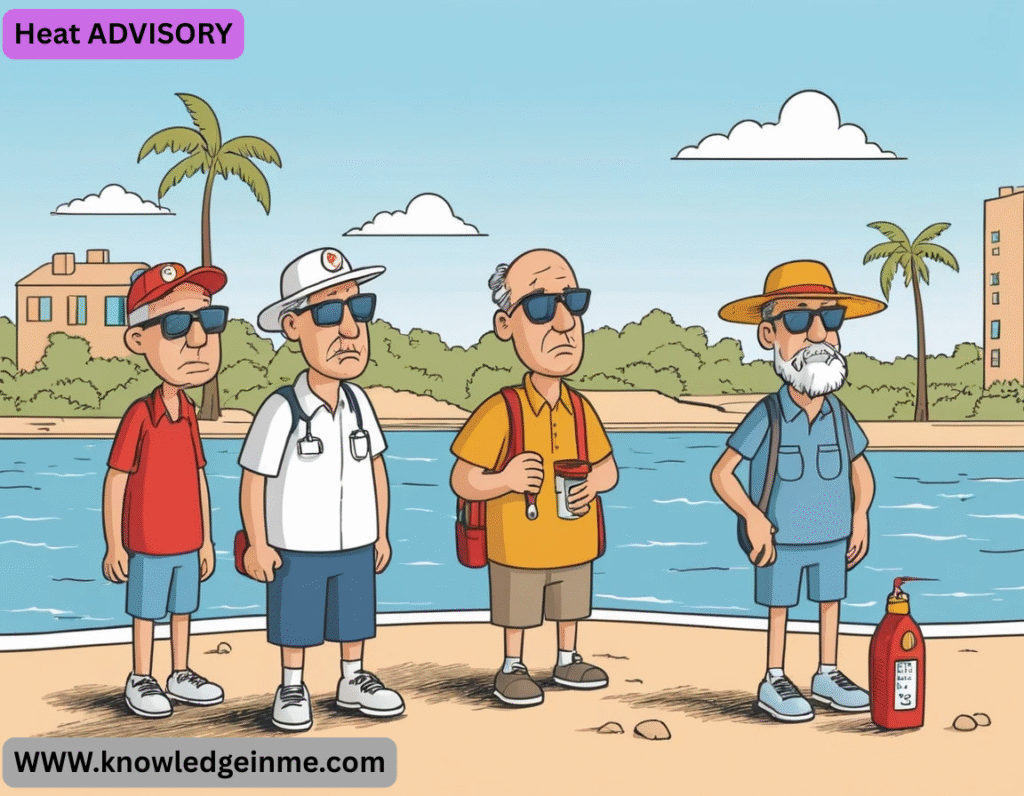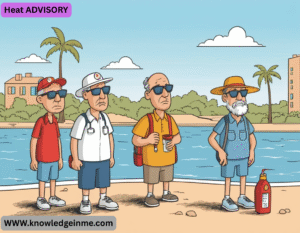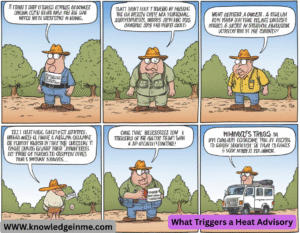Heat ADVISORY A Heat Advisory is issued when high temperatures and humidity levels are expected to combine to create dangerous conditions that could lead to heat-related illnesses, such as heat exhaustion or heat stroke. Here’s what you should know:
Key Details of a Heat Advisory
- Temperature: Typically when the heat index (feels-like temperature) reaches 100°F–104°F (38°C–40°C) for at least 2 days.
- Humidity: High moisture in the air reduces the body’s ability to cool itself through sweat.
- Timing: Usually in effect during the hottest part of the day (late morning to early evening).
Health Risks
- Heat exhaustion (symptoms: heavy sweating, weakness, dizziness, nausea).
- Heat stroke (life-threatening—symptoms: high body temp, confusion, loss of consciousness).
- Higher risk for elderly, children, outdoor workers, and pets.
Safety Tips
- Stay hydrated (drink water, avoid alcohol/caffeine).
- Stay indoors in air conditioning if possible.
- Wear lightweight, light-colored clothing.
- Never leave children or pets in parked cars.
- Check on elderly neighbors and vulnerable individuals.
- Limit strenuous outdoor activities (exercise, yard work, etc.).
What Triggers a Heat Advisory
- Heat index (“feels-like” temp) reaches 100°F–104°F (38°C–40°C) for at least 2+ hours.
- Nighttime lows stay above 75°F (24°C), preventing recovery from daytime heat.
- High humidity (60%+) makes sweating less effective at cooling the body.
- (Criteria may vary slightly by region—e.g., lower thresholds in northern states.)
Heat-Related Illnesses: Symptoms & Emergency Response
Condition Symptoms What to Do
Heat Cramps Muscle pain/spasms (legs, abdomen) Rest, drink electrolytes, stretch gently.
Heat Exhaustion Heavy sweating, dizziness, nausea, clammy skin Move to AC, sip water, cool compresses.
Heat Stroke ( LIFE-THREATENING) Hot/dry skin, confusion, rapid pulse, unconsciousness CALL 911, cool body ASAP (ice packs, fan, cold bath).
At-risk groups: Infants, elderly (65+), outdoor workers, athletes, people with chronic illnesses (heart disease, diabetes), and pets.
Extended Safety Precautions
At Home:
- Close blinds/curtains during peak sun (10 AM–4 PM).
- Use fans + open windows at night if no AC (cross-ventilation helps).
- Avoid using ovens/stoves—opt for microwave or grill outside.
- Check fridge/freezer temps (food spoils faster in heat).
Outdoors
- Wear UPF clothing + wide-brimmed hat.
- Pavement burns: Asphalt can reach 145°F (63°C)—test with hand before walking pets.
For Pets & Animals
- Walk dogs early/late (paws burn on hot pavement).
- Provide shade + extra water (bowls can tip—use heavy containers).
Long-Term Risks of Extreme Heat
- Power outages (overloaded grids from AC use).
- Poor air quality (heat + pollution = smog; worsens asthma).
- Dehydration leading to kidney strain or UTIs.
Resources During a Heat Advisory
- Cooling Centers: Libraries, malls, or city-designated shelters (search local gov’t website).
- Utility Assistance: Some states offer help with AC bills (e.g., LIHEAP in the U.S.).
- Weather Alerts: Enable Wireless Emergency Alerts (WEA) on your phone for updates.
The Science Behind Heat Advisories
How the Heat Index is Calculated
- Formula: Combines air temperature + relative humidity using the ROTHFUSZ equation (NWS standard).
- Example: 95°F (35°C) + 60% humidity = Heat Index of 114°F (45.5°C).
- Wet Bulb Globe Temperature (WBGT): Used by athletes/military, accounts for sun, wind, and humidity (more accurate than heat index).
Why Humidity Matters
- At 100% humidity, sweat cannot evaporate, halting the body’s primary cooling mechanism.
- Danger threshold: Wet-bulb temps above 95°F (35°C) are unsur vivable for more than 6 hours (even for healthy adults).
Hidden Health Impacts
Lesser-Known Effects of Extreme Heat
- Cognitive Decline: Studies show a 10–20% drop in focus/decision-making above 90°F (32°C).
Medication Risks
- Diuretics (water pills) → dehydration.
- Beta-blockers → reduced sweating.
- Antidepressants (SSRIs) → impair temperature regulation.
- Pregnancy Risks: Linked to preterm birth + low birth weight (per JAMA Network studies).
Urban Heat Island Effect
- Cities can be 10–15°F (5–8°C) hotter than rural areas due to:
- Concrete/asphalt absorbing heat.
- Lack of trees/shade.
- Waste heat from cars/AC units.
Global Heat Policies & Comparisons
Country Heat Action Plans Unique Measures
India “Cool Roofs” program (white paint to reflect sunlight). Shuts schools at 113°F (45°C).
France Mandates AC in elder-care facilities. “Cool Rooms” in public buildings.
Australia “Beat the Heat” SMS alerts. Free public pools during heatwaves.
U.S. Varies by state; OSHA mandates water/rest for outdoor workers. Phoenix, AZ, has a Heat Response Coordinator.
Cutting-Edge Cooling Solutions
Personal Cooling
- Phase-Change Materials (PCMs): Vests with cooling gel packs (used by NASA, firefighters).
- Misting Fans: Lowers ambient temp by 15–20°F (8–11°C) via evaporative cooling.
Architecture/Urban Design
- Green Roofs/Walls: Plants reduce building temps by 50°F (10°C).
- Porous Pavement: Reflects sunlight + absorbs rainwater to cool streets.
Emergency Tech
- Smart Thermometers: Wearables that alert users to early heat stress signs.
- Drone Deliveries: Used in India to send water/meds during heatwaves.
Future Climate Projections
- By 2050, 1 billion people will face lethal heat annually (PNAS study).
- Most at-risk U.S. cities: Phoenix, Miami, Houston (high heat + humidity).
- Economic cost: Heat could reduce global GDP by 3.5% by 2100 (Climate Impact Lab).
What You Can Do Beyond Basics
Advocacy & Preparedness
- Push for urban tree-planting programs (shade reduces asphalt temps by 20–45°F).
- Insulate your home to reduce AC dependency (check for gov’t rebates).
- Create a neighborhood “heat buddy” system to check on vulnerable residents.
DIY Cooling Hacks
- Frozen Socks: Wear damp socks chilled in the freezer (cools blood vessels in feet).
When Heat Advisories Escalate
- State of Emergency: Declared during power grid failures (e.g., Texas 2023).
MICROCLIMATE HEAT TRAPS: WHERE DANGER HIDES
- Parking Lots: Asphalt radiates heat for 6+ hours after sunset (measure with IR thermometer).
- High-Rise Apartments: Top floors can be 15°F hotter due to “stack effect” heat rise.
- Public Transit: Un-air-conditioned subway platforms reach 120°F+ (NYC/NYC studies).
- Cars: Dashboard temps hit 180°F (82°C) within 1 hour at 90°F ambient (AAA data).
- Solution: Carry a pocket heat sensor (like Thermo Works Thermometer) to detect danger zones.
HYDRATION HACKS BEYOND WATER
- Electrolyte Gold Ratio: 500ml water + 1/4 tsp salt + 1/4 tsp potassium (Nuun tablets work).
- Coconut Water: Natural potassium (600mg/cup) but high sugar—dilute 50/50 with water.
GLOBAL HEAT DISASTER CASE STUDIES
- 1995 Chicago: 5-day heatwave killed 739—mostly in “heat island” neighborhoods.
- Lesson: Wealthy areas have 8x more trees than low-income zones (per EPA EJSCREEN).
FUTURE TECH AGAINST HEAT
- Personal AC: Sony’s Reon Pocket (wearable thermoelectric cooler).
- Smart Clothing: MIT’s liquid-cooled suits for construction workers.
- AI Prediction: Google’s Hyperlocal Heat Alerts (500m resolution).
Coming Soon
- NASA-inspired “Cool Coating” for roofs (reflects 98% sunlight).
- EU-mandated “Heat Passports” for vulnerable populations.
ULTIMATE HEAT EMERGENCY KIT
- Core Items: Instant cold packs (for groin/armpits if heat stroke).
- Oral rehydration salts (WHO formula).
- Mylar emergency blanket (reflects 90% body heat).
Tech Add-Ons:
- Ember Wave phase-change cooling towel.
- Garmin body battery monitor for heat stress.
Car Survival:
- Window breaker/seatbelt cutter (in case of vehicle heat entrapment).
WHEN TO EVACUATE YOUR HOME
- Indoor temp >95°F for 12+ hours without cooling.
- Power outage >4 hours during daytime heat.
- Confusion/dizziness in household members (even with AC).
- Safe Havens: Movie theaters, libraries, or parked RVs (better insulation than tents).
10. HEAT DATA RESOURCES
- Real-time WBGT: NOAA’s Heat Risk Tool (hourly forecasts).
- Air Quality: Purple Air crowdsourced sensors.
- Cooling Centers: Aunt Bertha (social services locator).






